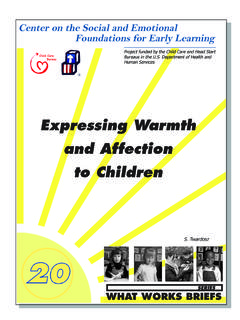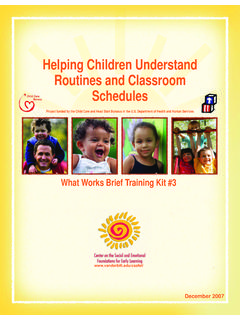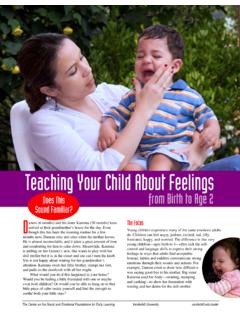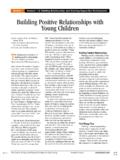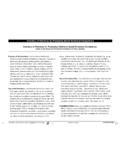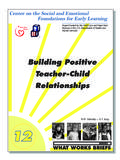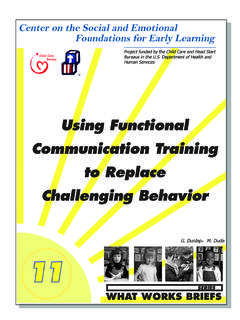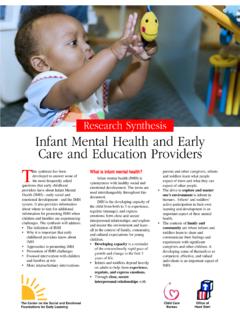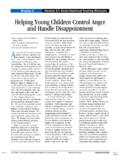Transcription of Module 2 Handout 2.6: Social Emotional Teaching Strategies ...
1 Module 2 Handout : Social Emotional Teaching Strategies Enhancing Emotional Vocabulary in Young children Gail E. Joseph, & Phillip S. animal and ask her classmates if the gets a big hat and takes it to April. Strain, zebra can come to the party. April just frowns and goes about Center on Evidence Based Practices In each of these cases, children tending to the hamster cage. Tamika for Early Learning experience some of the common, often- next takes the hat to Bo. Bo, she University of Colorado at Denver repeated challenges of life in preschool. says, let's go play. Again she is Shantay, in the end, was overwhelmed rebuffed. Finally Tamika finds a play by his feelings of frustration. Unable to partner in Darrin; who is walking from F. our-year-old Shantay is an avid builder with blocks. At free play label his legitimate feeling he acted- one activity area to the next.
2 He has busied himself with an out a sure recipe for not getting his In these two scenarios great elaborate tower construction. To needs met. Kelly, equally upset and, in variation can be noted in children 's complete his masterpiece he needs an this example, paralyzed temporarily by ability to read Social cues. Tony's elusive triangle piece. As he searches her Social anxiety was able to achieve choice of rough and tumble partners is the room in vain for the last, crucial an outcome she deeply desired. She ubiquitous. His inability to read Social piece his initial calm hunt becomes was able to do this by the good cues ultimately resulted in a poor more hurried and disorganized. He Teaching that had previously occurred. outcome. Tamika, on the other hand, begins to whimper and disrupt other She was able to communicate her need was readily able to read Social cues children 's play.
3 His teacher approaches and access strategic help to get that and, as a result of good Teaching , she and asks what the matter is. Shantay need met. In contrast with Shantay, had a strategy (try again with another swiftly turns away to resume his now Kelly's experience demonstrates one of friend) to achieve her desired outcome. frantic search. This behavior persists the ways that Emotional literacy Figure 1 below provides an overall for several minutes until the signal for enables children to be socially schematic of children 's Emotional cleanup is given, whereupon Shantay competent. Consider two other case literacy (Crick & Dodge, 1994;. launches into a major, 15-minute examples of Emotional literacy at work. Lemerise & Arsenio, 2000). Note first tantrum. Tony is a master of rough and that the foundational element, the tumble play. As a game of superheroes necessary context, for Emotional Four-year-old Kelly is relatively commences, Tony runs headlong into literacy development is a supportive, new to preschool.
4 She wants to play other children . Two of his playmates caring relationship (see Joseph &. with her new classmates, but is too shy happily reciprocate; smiling and Strain, 2002). In order to act upon the and frightened to approach and join in giggling they continue their preschool Social environment in ways that are with the group. This day at free play version of slam dancing. Tony, collectively supportive and rewarding she intently watches, as three other however, seeks out other partners as it is first necessary for children to read girls are absorbed in an elaborate tea well. In particular, Eddie and Darrin the affective cues of others and of party, complete with pandas and want no part of this. They frown as he themselves. Discriminating among wolves. With a forlorn look, Kelly approaches and yell, No. Tony affective states such as anger, sadness, passively observes the ongoing play.
5 Seems to interpret their behavior as an frustration, and happiness requires a Her teacher approaches and says, invitation for more. Both Eddie and vocabulary of feeling words . Like Honey, is something wrong? Kelly Darrin start to cry and quickly seek out other forms of literacy the richer the shrugs her shoulders. Her teacher their teacher who has Tony sit quietly vocabulary, the more rewarding the persists, Kelly are you frustrated? for 2 minutes while play continues. experiences. In this article we will Kelly says, Yes. Her teacher then This time-out angers Tony and he pouts concentrate on how to build a reminds her of the class rule; if you alone for the remainder of free play. meaningful lexicon of feeling words . feel frustrated, ask a friend or teacher Tamika loves to play dress-up. This This instructional emphasis bears, not for help. Kelly and her teacher quickly day at free play she asks Seth to join coincidentally, a close resemblance to discuss how she might get another her, but he says, Later, and goes cognitive behavior modification about his computer play.
6 Tamika then (Meichelbaum, 1976). Rev. 2/10 The Center on the Social and Emotional Foundations for Early Learning Vanderbilt University H (p. 1/5). Module 2 Handout : Social Emotional Teaching Strategies Emotional Literacy Schematic prerequisite skill to Emotional regulation and successful interpersonal interactions and problem solving and is one of the most important skills a child is taught in the early years (Denham,1986; Webster-Stratton, 1999). Limited Emotional literacy, on the other hand, can result in misperceptions of feeling in one's self and others. Building Emotional vocabulary In order to correctly perceive feelings in yourself and others, you first have to have words for those feelings , a feeling lexicon. Many children are either happy or mad . and miss all the subtle gradations of feelings in-between because they do not have labels and definitions for Figure 1.
7 Emotional Literacy Schematic those emotions. A large and more complex feeling vocabulary allows Once children are reading and The clarification of goals then children to make finer discriminations correctly labeling affective cues from allows children to generate solutions to between feelings ; to better words , internal stimuli, and body achieve their goals. Solutions might communicate with others about their language they then proceed to make include a self-regulation notion such as, internal affective states; and to engage crucial judgments about both the cause I need to calm down. Solutions in discussions about their personal and the intent of other's affect ( , might be trying again, finding someone experiences with the world. children Tamika has, appropriately, a neutral to help, trying a different way, and so with disabilities (Feldman, McGee, judgment abut peers' lack of interest in on.))
8 Solution generation, however, must Mann & Strain, 1993; Walker, 1981). her play and she simply proceeds to be followed by a contingent decision- and children from low income families look until she finds a willing partner). making paradigm. For example, (Eisneberg, 1999; Hart & Risley, 1995;. Many children , however, make crucial children might be taught to consider if Lewis & Michalson, 1993) have more errors at this point. Partly because of an the solution is fair, if it has worked limited feeling vocabularies than their absence of feeling words they often before, if it is a safe, if it would result typically developing and middle interpret the behavior of others as in positive feelings , and so on. Finally, income peers. Parents and teachers can intentionally hurtful and eventually act children act in accordance with their foster Emotional vocabulary by out in ways that invariably lead to decision.
9 While we will focus only on Teaching feeling words and their Social isolation and stigmatization establishing a vocabulary of feeling Emotional definitions. Adults can (Kazdin, 1989). words that permit accurate reading of increase children 's feelings words by Once children make a judgment affective cues and accurate Teaching different feeling words and about cause and intent they proceed, in interpretation of cause and intent, definitions directly; incidentally in the this model, to clarify their interpersonal teachers needs to be aware that many context of conversation and play; and goals. In earlier examples, Tony children will require careful step-by- through special activities. wanted to play rough and tumble, step instruction from reading affective Adults can teach feeling words Tamika wanted to play dress-up, Kelly cues to acting on decisions.
10 Directly by pairing a picture or photo of wanted to join in the tea party, and Emotional literacy is the ability to a feeling face with the appropriate Shantay just wanted that final block. recognize, label, and understand affective label. Preschoolers are better feelings in one's self and others. It is a at recognizing feelings with drawn Rev. 2/10 The Center on the Social and Emotional Foundations for Early Learning Vanderbilt University H (p. 2/5). Module 2 Handout : Social Emotional Teaching Strategies pictures at first then progressing to with steps to regulate or calm down. A throughout the day as their feelings photographs. children 's books are an first step would be to vocalize this change. Teachers can make feeling excellent way to label feeling faces negative feeling ( I'm mad ) versus dice by covering small milk cartons with children .
